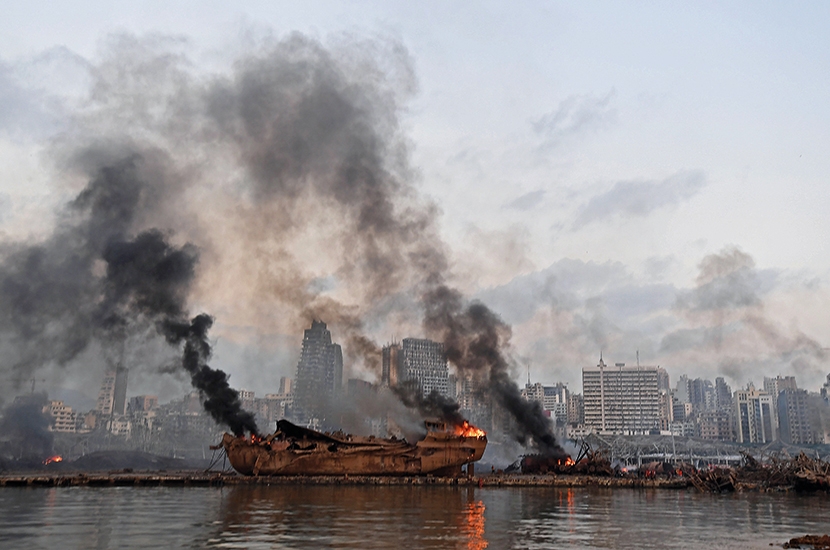Mountains are humanity’s most comforting topographical feature. Wherever you find them you will also find those who have flocked to them for refuge. The Kurds, the world’s largest stateless people, span the most mountainous areas of their host states, while ‘Lebanon’ referred originally to the mountains in the eastern Mediterranean that for centuries served as a haven for all the region’s minorities. First came the Christian Maronites, fleeing the persecution of the Orthodox Byzantine Empire in the 7th century; then in the 10th and 11th centuries the Shiite Muslims, persecuted by the Sunni powers; followed by the Druze, persecuted by the Shiites.
These are the origins of the modern multi-ethnic Lebanese state that, as Charif Majdalani observes in this powerful and original book, made the nation a bridge ‘straddling the great cultures of the East and the West’. But this heterogeneity was also a curse — ‘the source of all the conflicts to come’ — because it forced upon the Lebanese a confessional state system which distributed political office according to religion and sect. The perennial squabbling eventually led to civil war and the emergence of sectarian warlords who seized control of the government and public sector, creating the vertiginous ‘clientelism and corruption’ which brought about the collapse of the country last year. It is this disaster that Majdalani seeks to document day to day throughout key months in 2020.
The book, then, is most obviously a diary of a society which is imploding: a newsreel depicting the type of Middle East collapse we have come to expect, ‘inexhaustible, ad nauseam’. It is a story of the ‘economic collapse, the bankruptcy of the country, capital control, exchange rates, the pound in free fall, inflation and penury lying in wait for us all’, as Lebanon tumbles into ruin. Majdalani spends his days
running from one bank to the other, converting dollars into pounds at the official exchange rate, then comparing that to the banks’ rates, then to the changers’, then to the black market rate… before getting completely muddled and giving up on the whole thing.
The explosion seems darkly inevitable – the physical manifestation of Lebanon’s societal collapse
The broad dysfunction is interwoven with personal details, which brings the crisis alive. Take anti-mosquito coils: Majdalani can’t find any to stop him getting devoured every night and assumes it’s because of general shortages in the supermarkets. Then he’s told that the lack of electricity prevents using plug-in devices, so everyone has resorted to the old-fashioned burning ones, which have sold out. This is what it means to suffer in Lebanon now: to end up ‘suddenly defenceless, even against the bugs’.
The journal reaches a climax — or rather nadir — on 4 August, when ammonium nitrate stored in a warehouse in Beirut port explodes, killing more than 200 people and making 300,000 homeless. Majdalani breaks off mid entry and can only return to it days later. Finally putting pen to paper, he sees the explosion as almost darkly inevitable — the physical manifestation of Lebanon’s societal collapse:
As if this degeneration were not swift enough, some unknown malignant force decided to precipitate it, and in a matter of seconds hurled everything that was still standing to the ground.
It’s a striking image. But if much of the book’s emotional power is channelled through its coverage of daily life in 2020, its analytical force is found in the broader themes it considers. Lebanon was founded in 1920 and Majdalani is acutely alive to ‘the irony of fate that brought a country to its ruin on the anniversary of its birth’, and he asks one question above all others: ‘How far back should I go, in those 100 years, to trace the genealogy of this disaster?’
So we return to the mountains. The disparate communities they brought together demanded, and obtained, independence, and then tried to find a way of avoiding conflict by decreeing that the new Lebanon was neither a western country, as the Christians hoped, nor an Arab country, as the Muslims wanted. This was, Majdalani notes, ‘the famous affirmation of national identity by a double negative’. Little wonder, then, that the country has been plagued by strife: it was born of competing sectarian visions.
But a century on, as Beirut’s port explodes and Lebanon experiences one of its greatest tragedies, Majdalani sees perhaps a sign of hope. In this divided land, nowhere more sundered than in its capital, he understands that:
Everyone in the city seems to have experienced the same long nightmarish seconds, and that’s what is so incomprehensible, because each of us thought at the time that it was just our house, our neighbourhood, our street that was targeted, and we realise that we all were, at the same time.






Comments